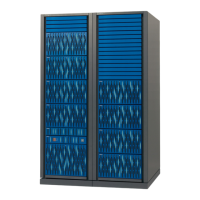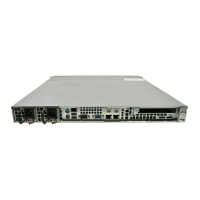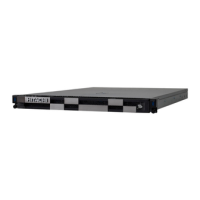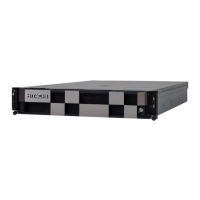P-VOL Side S-VOL Side
• Unfreeze DB on opening P-VOL by
application.
• Resynchronize the paired volume
using pairresync -g ORB.
Offline backup using raidscan -find sync for Windows NT file system:
The raidscan -find sync command flushes the system buffer through
finding a logical drive corresponding to a group of the configuration file,
without using the -x mount and -x umount commands. The following
examples are for group ORB.
P-VOL Side S-VOL Side
Close all logical drives on the P-VOL by
application.
• Flush the system buffer for P-VOL
using raidscan -pi $LETALL -find
sync -g ORB.
• Split the paired volume using
pairsplit -g ORB with r/w mode.
• Open all logical drives on the P-VOL
by application.
• Resynchronize the paired volume
using pairresync -g ORB.
• Back up the S-VOL data.
• Flush the system buffer for S-VOL
updates using raidscan -pi $LETALL -find
sync -g ORB when the backup is finished.
Online backup using raidscan -find sync for Windows NT file system:
The raidscan -find sync command flushes the system buffer through
finding a logical drive corresponding to a group of the configuration file,
without using the -x mount and -x umount commands. The following
examples are for group ORB.
P-VOL Side S-VOL Side
Freeze DB on opening P-VOL by
application.
• Flush the system buffer for P-VOL
using the raidscan -pi $LETALL -
find sync -g ORB.
• Splits the paired volume using
pairsplit -g ORB with r/w mode.
• Unfreeze DB on opening P-VOL by
application.
• Resynchronize the paired volume
using pairresync -g ORB.
• Back up the S-VOL data.
• Flush the system buffer for S-VOL updates
using raidscan -pi $LETALL -find sync -g
ORB when the backup is finished.
Note:
• P-VOL side must stop the WRITE IO to the logical drive corresponding to
a [-g name] before issuing the raidscan -find sync command.
8-8
Examples of using CCI commands
Command Control Interface User and Reference Guide

